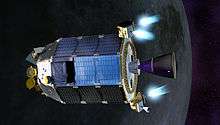Prospector (spacecraft)
Prospector was a proposed lunar probe that was intended to be flown in support of the Apollo lunar missions.[1]
Prospector arose as a result of President John F. Kennedy's desire to rehabilitate the tarnished image of US spaceflight. In 1961, NASA proposed a series of unmanned probes, including Prospector, to be managed by the Jet Propulsion Laboratory.[2]
Prospector was based on a study that had been performed by the Marshall Space Flight Center in June 1960, to determine what lunar missions could be achieved using the Saturn I rocket.
NASA envisioned Prospector as "a large versatile 'space truck'"[3] that could be launched by a Saturn rocket and that could soft-land on the Moon with a wide variety of payloads. Among the applications envisioned were:[3]
- a remote-controlled lunar rover that could explore large areas of the lunar surface, including the far side of the Moon;[2]
- a system to obtain lunar samples and return them to Earth;
- low-altitude survey of the lunar surface for reconnaissance and to help select landing sites for the later Apollo missions, using large propellant tanks to allow the spacecraft to hover and laterally move over the lunar surface; and
- As an unmanned resupply spacecraft, providing supplies and materials to lunar astronauts.
Prospector was initially planned to have its first launch between 1963 and 1966.[4] However, as plans progressed, the project ran into weight overruns, requiring a larger launcher such as the Saturn V.[2] It also began to change its role from being in support of the Apollo missions to more of a substitute,[2] and NASA's Space Task Group did not support it.[5] The project was canceled in 1962.[2]
See also
References
- ↑ Fozzy, Paula (February 1962). "Lunar Program Underway". Bulletin of the Atomic Scientists. 17 (2): 37–38. ISSN 0096-3402.
- 1 2 3 4 5 Ulivi, Paolo; Harland, David Michael (2004). Lunar exploration: human pioneers and robotic surveyors. Springer. pp. 39–40. ISBN 9781852337469.
- 1 2 "Fifth Semiannual Report to Congress". May 28, 2962. NASA. p. 50. Retrieved March 21, 2012.
- ↑ "Weird Robots to Explore the Moon". Popular Science. March 1962. pp. 96, 97. Retrieved March 21, 2012.
- ↑ "The Apollo Spacecraft - A Chronology". NASA Special Publication-4009. NASA. Retrieved March 20, 2012. Volume 1, Part 2(c), citing Memorandum, H. Kurt Strass, Apollo Project Office, to Associate Director, STG, Conference at NASA Headquarters Concerning Relationship Between the Prospector and Apollo Programs, April 20, 1961, May 1, 1961.
External links
- Prospector at the Encyclopedia Astronautica



